Lessons from the New Arcade
Primary Exploration in Games
Follow our RSS feed! Subscribe by clicking right here.

If there were a Rosetta Stone, so to speak, that allowed hardcore game designers to translate their game ideas into a casual format, it would be quite a breakthrough. There is no shortage of traditionally hardcore designers and AAA companies with an interest in the burgeoning casual games market. What prevents this is that the cornerstone of hardcore games—the deep mastery of skills—cannot always be easily converted to a casual format. Most hardcore games have a greater overall length than their casual counterparts, and each play session tends to be longer too. Indeed, one of the hallmarks of a casual game is that it can be played in short sessions (this essay touches on one reason why that’s true, later), but that doesn’t mean the casual game has to be short. Most designers realize from the start that casual games cannot be extended with purely hardcore game design techniques. There is, however, a solution that allows casual games to achieve the same result with a design idea that is similar in function but different in its structure. This essay highlights this analogous design technique that extends casual games. Specifically it looks at how two online hits from 2010—“Flight” and “Corporation Inc”—create deeper and longer-lasting gameplay within a casual framework.
(As for why I chose these two particular titles out of so many similar casual games: many games exhibit the same patterns in design, many are indeed almost clones. Ultimately, however, few exhibit the positive traits I saw quite so clearly. Also, my data sources are at the end. It's not what you'd call a hard-and-fast citation, considering where it came from--but if you must know, see the end.)
The general idea is that “Flight”, “Corporation Inc.”, and many other new casual games trade in the cornerstone of hardcore gameplay—mastery of skills—for a different way of making games deeply fun—the exploration of skills. The hardcore mastery of skills, its progression and its result in “flow” have all been studied thoroughly. We know a lot about why mastering skills is a fun activity, and why it has worked so well in the hardcore market for so long: learning is fun. Hardcore players will spend a lot of time learning a difficult set of skills, and in a well-made game they will have progressively more intense fun as their skill and the difficulty of the game increase in sync. Some casual games mimic this, but many like the two mentioned earlier do something else. Instead of having one very deep set of skills to master, they have a larger number of less complicated skills to “explore.”
Defining Mastery and Exploration
The central tenet of conventional videogame design is that a game should get more difficult in sync with the player, as he or she learns and becomes more skilled. In most games, the last level is harder than the first level. In most games the end requires more skills and better skills than the beginning. For the most part this is true in both hardcore games and casual games, although hardcore games follow that pattern more strictly.
The general trend with hardcore games is that the skills they have to teach require a lot of investment in terms of time and energy. Hardcore games need to be played in longer sessions because it’s hard to acquire mastery of a complex set of skills by practicing in bursts of ten minutes or less. There are too many factors; there is too much to learn. In hardcore games playing 30-90 minutes per session is fairly normal. The fact that these games take a long time to master also explains why hardcore gamers don’t always seem to be having fun while they’re playing. A hardcore gamer will patiently play a frustrating game for hours because they know that the highest level of enjoyment will come later. Hardcore games also tend to have more total time per title because once the player masters deep skills, they want to use those skills for a proportionately long while or there’s no “payoff.”
Casual games, on the other hand, don’t always require a large investment in time and energy. It is possible to play many casual games for short bursts, and often it is possible to complete whole games in fifteen minutes to an hour. The obvious conclusion to draw here is that casual games usually teach and use skills whose ceiling for mastery is much lower than their hardcore counterparts. We can visualize this discrepancy on a graph:
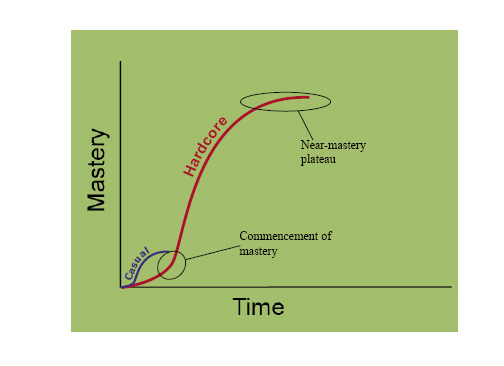
Obviously this is why most of the casual games are shorter than their hardcore counterparts: there is nothing left to master, so gameplay can only continue for so long. Of course there are exceptions to this rule in games like Bejeweled and “Diner Dash,” certain versions of which can become engrossing in the same way hardcore titles are, skill-wise.
Hardcore Exploration
Skill in hardcore games is not always simply a matter of concentrating on the mastery of one single set of skills that takes a player to the end of a game. Sometimes in a game there is a choice among equally valuable skill sets to choose from that allow for a fun, engrossing path to completion or victory. This is a fairly common phenomenon in games with character classes, different playable factions, and fighting games with large rosters. It’s best to see another visualization of how these skills work.
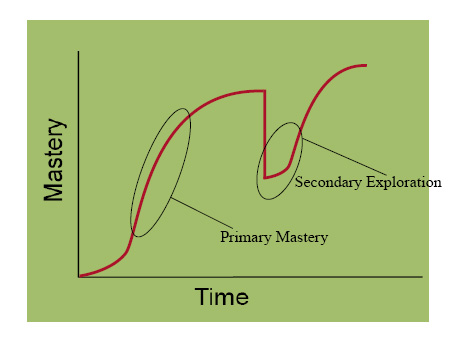
This is a hardcore learning curve in the presence of multiple skill sets of equal viability. Initially the player explores the various characters, factions, weapons, etc until they find one that they like; this is the assessment period. I call it assessment because the player is actively searching for something to master, rather than exploring the game’s features for the self-conscious sake of fun. The next period is the mastery of the selected skill-set. We can call this period “primary mastery” as it is the first major investment by the player.Toward the end of primary mastery most hardcore players will experience diminishing returns in effort, highlighted on both graphs. As it is with any skill from karate to playing the piano, the closer you are to complete mastery, the harder it is to make noticeable further progress. Because the last 10% or so of a game’s skill-set is the hardest to master, players will often take a break. In games where there are multiple skill-sets of equal value to master, players can take a break from primary mastery while still playing the same game. For example:
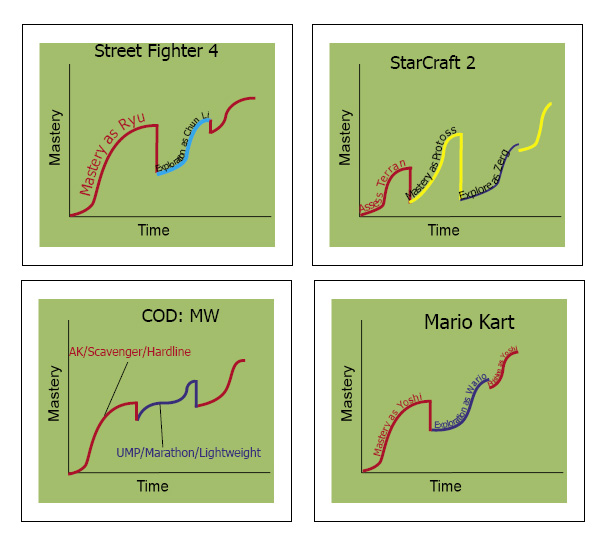
In a well-designed game, exploring some the other skill sets can actually help a player achieve the final bit of mastery in the primary one. The player who switches from Ryu to Chung-Li in Street Fighter 4 learns (incidentally) how to maximize their zone game and comes back to Ryu with the necessary insight and composure to finish mastering that character. The player who switches from protoss to zerg in StarCraft 2 learns how to not rely on a single type of high-tech unit when attacking, and returns to protoss with a more flexible strategy. The player who has been racing as Yoshi in Mario Kart for a long time switches to Wario for variety, and learns to plan ahead on the race course so they can take corners more aggressively.
This period, where the player has discontinued their initial mastery of one set of skills can be called the meditation period. There is a strong likelihood that the player will return to the skills they honed during primary mastery, even if they don’t explore other skills; some time away from the game will help them get back to their mastery with greater enthusiasm and energy. But as discussed above, many players take this opportunity to learn a new character, faction or strategy in the same game since they’ve learned the basic skills of the game and enjoy playing it. When the player goes from focused mastery into a late survey of other options in the game, we can call it secondary exploration. Exploration of the game wasn’t their first goal, mastery was; but broader exploration became a valuable (and fun) pursuit because it helped them finish primary mastery.
There’s an interesting twist to game design in the study of mastery and exploration that acts as the bridge between hardcore games and casual games. One of the games graphed above, StarCraft 2, has two different kinds of learning curves. The first one is the primary mastery discussed already, but the second learning curve is one the designers cleverly built into the game: primary exploration. Although competitive multiplayer is the arena in which most StarCraft players achieve mastery, the designers built in an alternative that covers much of the same development of skills. One of the single-player options is the “challenge” missions, which are designed to build just a few specific skills each. Essentially each challenge acts as a much smaller mastery curve. (Although it’s still most definitely a hardcore game, every minute of the way.)
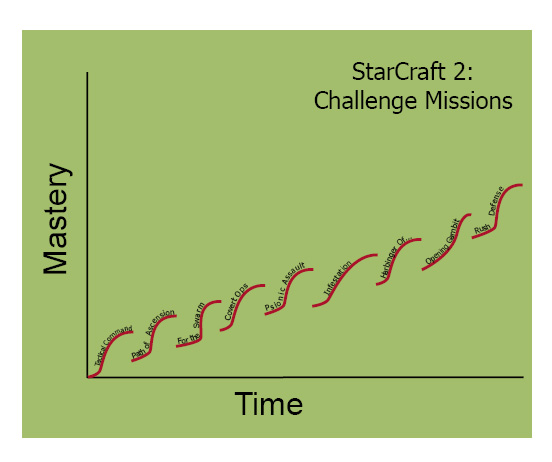
As you can see, each individual challenge can be mastered much more quickly than the game-wide skill-set. And yet players who complete these challenges will often start their multiplayer career at a very high level, even though they have no direct multiplayer experience.
What has happened here is that Starcraft’s designers allowed the player to choose primary exploration as the bulk of their learning curve. Instead of committing to one dense cluster of skills early, the player is able to sample all of them. Because the skills are so closely related, the player’s overall skill level rises after each small mastery curve is complete. After the exploration of the skills is complete, the player has ascended to a point where mastery of those game-wide skills is now as easy as it would be in the primary mastery scenario, if not easier. This can be termed secondary mastery, since it results in mastery but begins with exploration.
Casual Game Applications
Ultimately this article is about casual games, not hardcore games, and how primary exploration occurs in casual games. The two games I mentioned at the beginning, “Flight” and “Corporation Inc” both enjoy an enormously fun primary exploration period that constitutes the bulk of their gameplay. For those of you who are not familiar with these two games, they are both flash-based casual games published by Armor Games, although I did not find them through the Armor portal. I have no affiliation with Armor Games, although I do like many of the titles they publish. And finally I recognize that there are many games that do many of the same things that “Flight” and “Corporation Inc” do, (Burrito Bison leaps to mind) but I chose these two games because they reveal many key techniques in the practice of primary exploration as game design.
Flight is a 2-D paper airplane flight simulator that features a number of purchasable upgrades. The player throws the airplane with a mouse motion, and then uses upgraded features with the keyboard. The goal is to accumulate as much total distance as possible with the fewest number of throws. The player is rewarded with money for achieving long distances. That reward is augmented by in-flight powerups that either provide boosts to increase flight distance or directly reward money, or a combination of both. The in-flight powerups are a very large part of the gameplay, and it takes skill to obtain the right powerups at the right time in order to maximize flight distance and monetary gain.
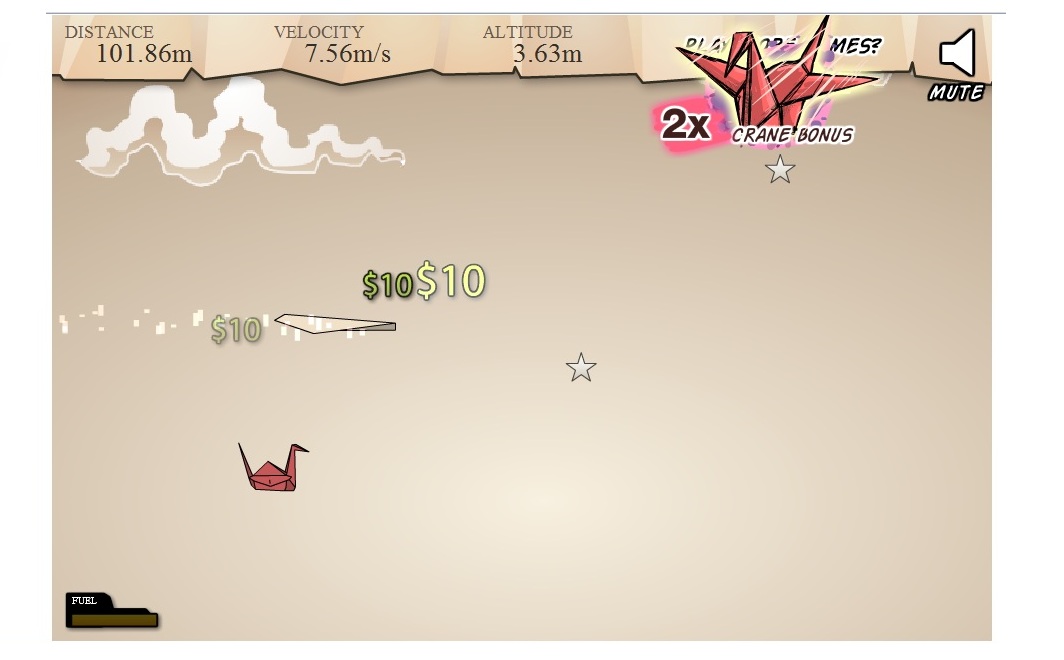
The standout aspect of the game’s design, however, is the purchasable permanent upgrades to the plane that augment various aspects of its flight. The “fire engine” upgrade attaches a turbo booster to the back of the plane that allows the player to propel the plane further at the cost of limited fuel. Similarly, there is an upgrade that allows for steering the plane mid-flight at the cost of fuel (the only in-flight resource). There are also upgrades to maintain the plane’s velocity for longer, consume less fuel per action, receive greater rewards per in-flight powerup, and bypass wind resistance, etc.
The important thing about those upgrades is that nearly all of them are very useful, and all of them are obviously useful. By that I mean that when you purchase an upgrade you can immediately see and feel the benefits in the gameplay. The steering upgrade has several levels of precision and efficiency to invest in, and coming from hardcore games you (the player) might expect that you’d have to upgrade the steering to the max level before you could experience a perceptible benefit; but that’s not the case. Each and every upgrade to the steering controls has a clear effect on their sensitivity. The same is true of the upgrades that affect fuel efficiency and the duration of the paper crane powerup. Investing in these upgrades has an immediate, clear effect that makes flying a little bit better and a little bit more complicated.
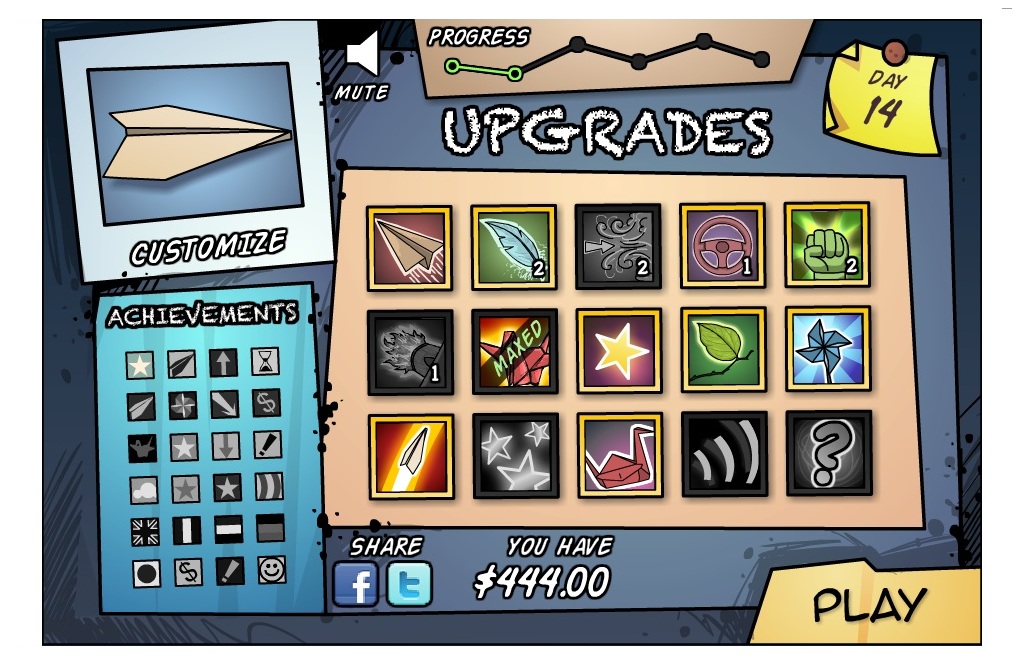
Most of the upgrades can be purchased in any order with great success. Steering control is more or less a lock for the first purchase, but from there, purchases can vary and still result in success and fun. Depending on whether players like to rely on in-flight powerups or whether they like fly in the straightest and most efficient path, they can choose a variety of ways to explore the upgrades according to their skills and preferences. Because every upgrade is so responsive in terms of how it extends the flight of the plane and how it allows the player to gradually incorporate more skills at their discretion, the player is afforded complete freedom in choosing skills.
“Corporation Inc” uses the same techniques in a context of very different skills. Whereas many of the skills in “Flight” are skills of the fingers and eyes—motor skills translated into precise, quick control of the airplane’s flight—“Corporation Inc” (hereafter CI) is almost entirely cerebral. CI has a pause button, which more or less eliminates the need to click quickly and consequently eliminates the need for much physical precision.
CI’s gameplay is all about making the right decisions. The goal is to make money and grow your corporation. To that end the player can hire button-pushers who are the producers in the economy. There are necessary support staffers in IT and Janitors; they make it possible for the producers to keep producing. There are managers and human resources personnel who enhance the productivity of the workers, and accountants that maximize the value of the “product”. And then there are researchers who make upgrades available.
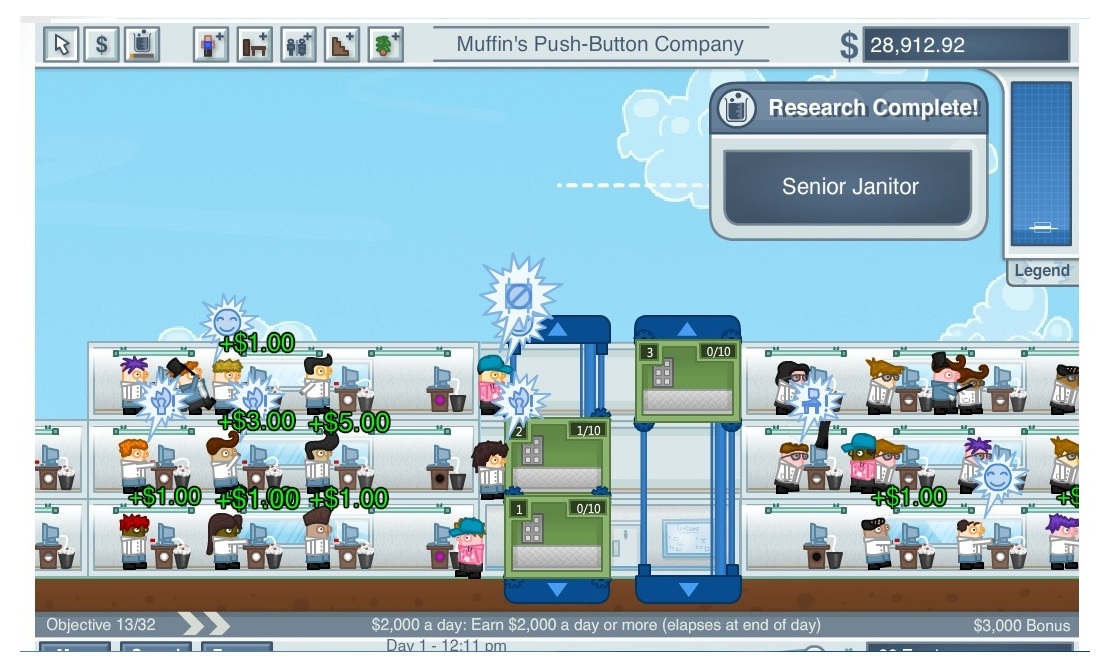
Much like in “Flight,” the upgrades in CI are robust and responsive, which allows for a lot of freedom in gameplay. As research is done (and players can modify how fast that happens as it suits them) various upgrades to the office building, its transportation systems, its amenities, and its workers become available. Upgrading an office suite to a higher level causes the producers to generate more money per task. Alternatively, it is possible to upgrade workers by promoting them. Players will see an immediate impact on their income and bottom line when upgrading and/or promoting, and it will happen fairly quickly. More than just affecting a daily income rate, the workers themselves will announce how much money they are generating. When augmented by a manager or an accountant or and advanced office, the worker will immediately start announcing their augmented production. As long as the upgrades are made during the workday, the feedback from the game will always tell the player how their hiring decisions have affected the game.
Although there is probably an “optimal” scenario for creating a corporation in CI, almost every upgrade and employee has a noticeable impact, especially at the beginning. The player may not feel the modifications to gameplay in their fingers, but it’s still obvious how their decisions are impacting the game. Because every choice is valuable, the player can experiment with various combinations as it suits them—without having to fear repeated failures.
A Hierarchy of Exploration
“Flight,” “Corporation Inc,” and many games like them allow players to access a non-linear array of interrelated skills; that is, they offer multiple, short, and interlocking paths of ascent to mastery. Every time the player invests in a skill (whether by upgrading or simply by activating and using a new skill) they become a little bit more skilled at the overall game. The “overall” skill is a result of the fact that all of the skills are interrelated. For example in “Flight” the ‘Aerodynamic’ upgrade reveals how extending the life of the plane’s velocity affects distance and controllability. That, in turn, clearly highlights the contributions of upgrades that increase velocity: Fire Engine, Crane Booster, Throwing Power. The steering controls that allow for more dexterous pursuit of the in-flight boosts reveal how valuable upgrading those boosts can be, and vice versa. Every skill reveals more about the nature and value of every other skill; every skill helps players maximize their performance. This gradual—and non-linear—accrual of skills in Primary Exploration accomplishes the same thing that Primary Mastery does in a hardcore game, but at no point is a player locked into an uphill battle with a hardcore skill chain. The analogous nature of the two gameplay models is clear below; you can see a fully explained version of the primary exploration model developed above: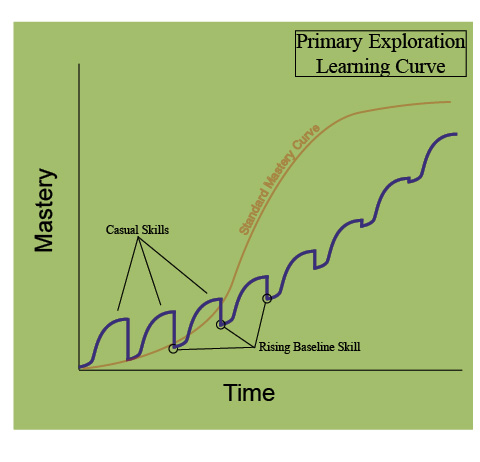
Like any generalized trend, this does not dictate how any one game operates; every skill will not be the same in growth rate, depth, or interconnectedness with other skills. This also highlights a general trend that as a player explores a greater number of skills, their overall improvement gets faster resulting in a steeper ascent to mastery. And finally it’s important to note that, for Primary Exploration, the skills should be explorable in any order (which is why they’re not labeled in the graph), or exploration will simply turn into a rather clunky mastery curve.
To hardcore designers (and perhaps hardcore players) Primary Exploration may seem like an unstructured mess that prevents designers from achieving any kind of vision and results in garbled games that never have the payoff of victory. Admittedly, this is the vision of a bad exploration game, but there are a few lessons to be learned from “Flight” and “Corporation Inc” that can help to replicate their success. The lessons are, naturally, design choices to opt for. In this case, these design choices take the shape of a hierarchy.
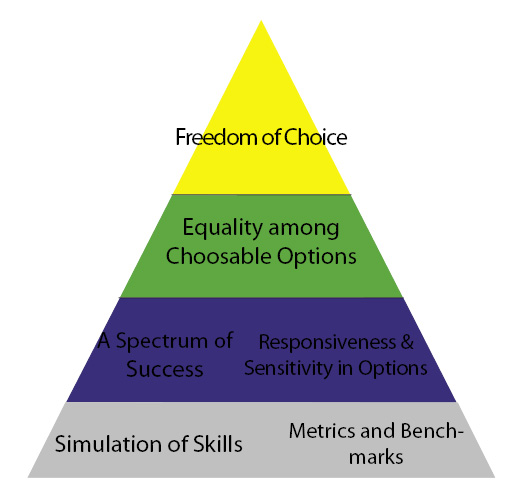
FREEDOM OF CHOICE: The player must be able to choose what skills and upgrades they develop or modify. If this is not so, the player has no agency except to master skills as in hardcore games, and you lose your casual audience. Accordingly, skills must not be locked in a linear skill chain; instead, at least a majority of them must accessible from the beginning for player to use at will.
EQUALITY AMONG CHOOSABLE OPTIONS: All the skill/upgrade options must be very close in gameplay value, or there can be no real choice among them. If one small set of skills is clearly better than all the others, the player can choose the less effective skills and upgrades, but they probably won’t choose them. Moreover, if the player sees a major discrepancy in the value of even a few skills, upgrades or decisions, they will often become cautious to the point of eliminating choice.
RESPONSIVENESS & SENSITIVITY IN CHOOSABLE OPTIONS: It must be absolutely clear to the player that each option is equally viable. If every upgrade, skill and decision is equally valid, but the player cannot tell that they are equal, the player may behave as though the options were unequal. Therefore each upgrade, skill and decision must have some kind of feedback mechanism that tells the player just how valuable it is.
A SPECTRUM OF SUCCESS: To be able to explore, the player must not fear failing and being set back too far, or players will only stick to the skills, upgrades, and decisions they made before their first major setback. Therefore the game must not present a strict “success/failure” dichotomy. Instead there should be a spectrum of success that allows the player to succeed to different degrees. Whether this means using high scores, achievements, level-up mechanics etc., it is important that the player can succeed in increments of varying (hopefully increasing) size. Failure can be an option, but certainly not the only one.
METRICS AND BENCHMARKS: Having a direct way for players to monitor their own progress is a huge help in exploration. A numerical (or some other kind of) scoring scheme that tracks player progress on an absolute scale is great because players can see the bottom line of their progress, whether it is improving, stagnant, or diminishing. That helps them understand the consequences of their decisions and the responsiveness of the upgrades and skills they’ve invested in.
Similarly, benchmarks are important for telling a player how they’re doing on a relative scale. A score of 500 is meaningless if a player doesn’t know whether a typical score is closer to 5 or 5000. Achievements are a great example of how benchmarks can be charted in a game. Players can see from the absolute scale how their progress is going relative to themselves, but they can see from the benchmarks whether their progress is ahead of the norm or behind it.
SIMULATION OF SKILLS: In this case simulation means that many of the “skills” the player masters are not just techniques that the player has to learn to master. Rather, the player can choose to invest in-game currencies to upgrade the skills of a player character, device, system, controllable unit, etc. For example RPG leveling systems are simulated skills; upgrades to a game vehicle are simulated modifications. The player doesn’t have to be quicker or more precise to reap their benefit.
Simulation of skills may well be the first obstacle that clever designers work around. Hardcore games have generated hundreds of vastly different ways to train player skills, but there are fewer that provide the necessary reward for player choice in primary exploration casual games.
Conclusion
Many gamers—indeed many designers even—are not old enough to really remember the videogame crash of the early 1980s. By 1983 many analysts and the buying public at large felt that videogames were a fad that was then over. It was only the emergence of the Nintendo Famicom and Super Mario Brothers that brought the industry back; and although they came out in 1985 the popularity of Nintendo didn’t really develop in the US until 1987. There were many reasons for the failure of early videogames, but a prominent one among those reasons was that in 1981 and 1982 the videogame market was flooded—quite heavily—with low-quality games by a host of publishers.
Free-to-play models and online distribution have placed casual games in a similar situation. I don’t think there’s any danger of videogames, causal games, or online free games of ever going away; our culture is too connected to them by now and the market is too interested. But the same flood of low-quality games is increasingly possible with accessible game development technologies, funding for indie titles and increasing numbers of distribution portals. To be fair, many of those portals are very responsible about publishing games of a reasonable level of quality.
Primary exploration is a tool for developers to use to make quality casual games; this will help prevent the saturation of the market with bad games. A longer game isn’t necessarily a better one, but primary exploration provides a way of making games deeper, not just longer. Because it is analogous to the time-tested hardcore mastery of skills, the casual exploration of skills can—and almost certainly will— see a lot more development. “Casual” does not mean “short,” and it most certainly doesn’t mean “simple.” Whatever casual might come to mean, “innovative” is likely to still be in the definition if the use of primary exploration is any indication.
Quasi-Citations
My data for these observations came from several of my playthroughs, those of my wife and several friends, as well as a number of internet sources. Shout out to Bloggy, Eventhumbs, GameFAQs.com, and many COD players who would mock my inquiries as often as answer them.
The Armor Games forums were of great use for studying those games--special mention goes out to the magnanamous nozo_ito the CI guru--and lots of youtube vids. As far as Youtube goes, thehannover07's vids were good, and usually would link me to many more videos of use. If any Armor senior staff read this post, feel free to send me any data you guys have mined on this! I'd love to be not smart enough to correctly arrange it; really, it would warm my heart.
The Starcraft-specific data came from extensive time on battle.net looking at hundreds of profiles of people who wiped the floor with my dessicated corpse... so to speak. Also, the SC2 forums are a great place to get data, if you don't mind it being guarded by a few trolls.
A more formal investigation of these principles is welcome. Thanks to everyone who helped make it happen.